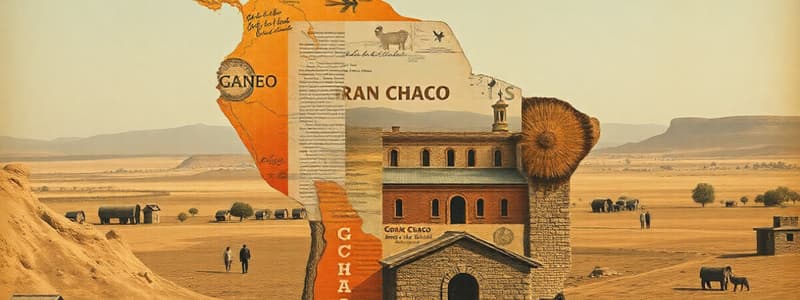Podcast
Questions and Answers
What was the main reason for the significance of the Gran Chaco during the 1930s?
What was the main reason for the significance of the Gran Chaco during the 1930s?
- Rumors of potential oil deposits increased its strategic importance. (correct)
- It was a major agricultural hub for Argentina.
- It was the first area to declare independence from the Spanish Empire.
- It served as a refuge for persecuted groups.
Which country gained approximately two-thirds of the disputed territory after the Chaco War?
Which country gained approximately two-thirds of the disputed territory after the Chaco War?
- Paraguay (correct)
- Argentina
- Bolivia
- Uruguay
What characterized the Chaco War between Paraguay and Bolivia?
What characterized the Chaco War between Paraguay and Bolivia?
- It was a non-violent negotiation over territory.
- Both countries faced severe resource limitations.
- It was primarily fought for colonial power.
- The war utilized newer industrial military technology, resulting in high casualties. (correct)
Who were the first major settlers in the Gran Chaco in the 1920s?
Who were the first major settlers in the Gran Chaco in the 1920s?
What is the predominant industry in the Gran Chaco region today?
What is the predominant industry in the Gran Chaco region today?
What consequences did the border disputes have on Paraguay and Bolivia by the 1920s?
What consequences did the border disputes have on Paraguay and Bolivia by the 1920s?
What development took place in the Gran Chaco during the 1960s?
What development took place in the Gran Chaco during the 1960s?
What is the approximate size of the Gran Chaco region?
What is the approximate size of the Gran Chaco region?
Which of the following is NOT a physical border of the Gran Chaco?
Which of the following is NOT a physical border of the Gran Chaco?
What does the name ''Chaco'' signify in Quechua?
What does the name ''Chaco'' signify in Quechua?
Why did the Spanish largely ignore the Gran Chaco region during colonization?
Why did the Spanish largely ignore the Gran Chaco region during colonization?
How was the Gran Chaco primarily used by early Amerindian cultures?
How was the Gran Chaco primarily used by early Amerindian cultures?
What significant change occurred in the early 19th century regarding the Gran Chaco?
What significant change occurred in the early 19th century regarding the Gran Chaco?
Which country does NOT share a border with the Gran Chaco?
Which country does NOT share a border with the Gran Chaco?
What type of ecosystem characterizes the Gran Chaco region?
What type of ecosystem characterizes the Gran Chaco region?
Flashcards
Gran Chaco location
Gran Chaco location
A vast, sparsely populated region in South America, approximately 850 square kilometers, mostly situated between Argentina, Bolivia, Paraguay, and Brazil.
Gran Chaco Population Density
Gran Chaco Population Density
The Gran Chaco has a very low population density, comparable to the area if the population of Connecticut were spread across the entire area of Texas.
Gran Chaco Physical Borders
Gran Chaco Physical Borders
Defined by physical landmarks: the Andes Mountains (west) and the Paraguay River (east).
Gran Chaco Political Borders
Gran Chaco Political Borders
Signup and view all the flashcards
Gran Chaco Early Inhabitants
Gran Chaco Early Inhabitants
Signup and view all the flashcards
Gran Chaco Spanish Exploration
Gran Chaco Spanish Exploration
Signup and view all the flashcards
Gran Chaco meaning of name
Gran Chaco meaning of name
Signup and view all the flashcards
Gran Chaco settlement
Gran Chaco settlement
Signup and view all the flashcards
Gran Chaco War
Gran Chaco War
Signup and view all the flashcards
Gran Chaco Territory
Gran Chaco Territory
Signup and view all the flashcards
Chaco War Casualties
Chaco War Casualties
Signup and view all the flashcards
Mennonite Migration
Mennonite Migration
Signup and view all the flashcards
Border Disputes in South America
Border Disputes in South America
Signup and view all the flashcards
Gran Chaco Development Efforts
Gran Chaco Development Efforts
Signup and view all the flashcards
Free-range Cattle Industry
Free-range Cattle Industry
Signup and view all the flashcards
Study Notes
Gran Chaco Overview
- Sparsely populated region in South America, larger than Texas, with ~4 million people.
- Roughly 850 square kilometers.
- Semi-arid, flat, with grasslands and low forests.
- Borderland geographically and politically between mountains and hills.
Physical Characteristics and Borders
- Western border: Andes Mountains
- Eastern border: Paraguay River
- Northern/Southern borders: Gradual transition to other land types.
- Political borders: Divided among Argentina, Bolivia, Paraguay, and a small part of Brazil.
Early History
- Name "Chaco" from Quechua, meaning "hunting grounds."
- Historically sparsely populated, primarily used for hunting by surrounding cultures.
- Spanish settlements outside the region, but largely ignored due to remoteness, lack of mineral resources, and resistance from indigenous groups.
- Sparse colonial activity, with cattle herding on the fringes.
- Significant settlement activity only began in the 1800s.
Border Disputes
- Independence wars (1810) led to division among Argentina, Paraguay, and Bolivia.
- Further boundary adjustments and conflicts, notably around 1870.
- Bolivia and Paraguay border disputes continued for decades.
- Chaco War (1932-1935): Bloody conflict (~85,000-130,000 casualties) over disputed territory.
- Primarily over land resources, with no oil found in the disputed territory.
- Paraguay gained most of the disputed land.
Gran Chaco Today
- Mennonite settlers from Canada (1920s) and USSR (1930s-1940s) formed communities within the region, due in part to persecution.
- Continued relatively underdeveloped compared to other parts of the region, even today, with free-range cattle being the primary industry.
- Development of highways (1960s onward) improved access but the region remains under-developed compared to the rest of the countries.
- Continued dependence on free-range cattle ranching.
Studying That Suits You
Use AI to generate personalized quizzes and flashcards to suit your learning preferences.




